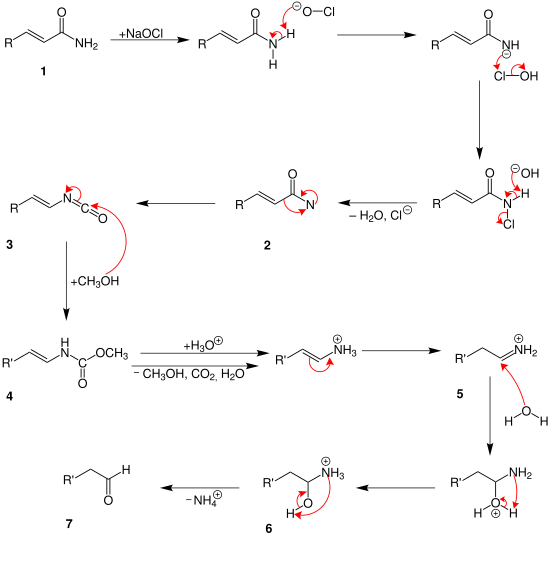User:Stolze Rose/Sandbox/Weerman degradation
The Weerman degradation, also named Weerman reaction, is a name reaction in the organic chemistry. It is named after Rudolf Adrian Weerman, who discovered this reaction in year 1910.[1] In general it is an organic reaction in carbohydrate chemistry in which amides is degraded by sodium hypochlorite, forming a aldehyde with one less carbon.[2]
Degradation of α-hydroxy-substituted carbonic acid amides
[edit]The Weermann degradation could be executed with α-hydroxy-substituted carbonic acid amides. For example sugar.
General Reaction Scheme
[edit]During the degradation of α-hydroxy-substituted carbonic acid amides, the carbon chain shortens about one carbon-atom.[2]

The reaction proceeds very slowly at room temperature, therefore the reaction mixture is heated up to 60-65°C.
Mechanism
[edit]The reaction mechanism is that of the related Hofmann degradation.[2]

At first the carbonic acid amide (1) reacts with the sodium hypochlorite. After the separation of water and chloride an amine with a free bond is built 2. The intermediate (3) is generated by rearrangement. In the next step a hydrolysis takes place. Water is added at the carbon-atom with the number '1'. A hydroxylic group is generated. The last step is that an acidic amide is separated and the aldehyde (4) is generated.
Degradation of α,β-unsattuered carbonic acid amides
[edit]Aditionally the Weerman degradation could be executed with α,β-unsattuered carbonic acid amides. For example acrylamide.
General Reaction Scheme
[edit]During the degradation of α-hydroxy-substituted carbonic acid amides, the carbonchain shortens about one carbon-atom,too.[2]

The reaction is very slow at room temperature, therefore the reaction mixture is heated up to 60-65°C.
Mechanism
[edit]The reaction mechanism is that of the related Hofmann degradation.[2]

At first the carbonic acid amide (1) reacts with the sodium hypochlorite. After separate water and chloride an amine with a free bond is build 2. The intermediate (3) is generated by rearrangement. At this point two different mechanisms are possible. In the mechanism above two methanol molecules reacts with the intermediate. So is the compound (4) generated. After this carbon dioxide, water, ammonium and methanol are separated in different steps. At least it is protonated into an aldehyde (5).

Until the intermediate (3) the mechanism is the same like above. Then only one methanol-atom is added 4. With a protonation water, methanol and carbon dioxide are separated. An ammonium ion (5) is generated. During the hydrolysis a hydroxylic group is built 6. An aldehyde (7) is generated by separating an ammonium ion.
Applications
[edit]One study demonstrated the direct oxidation of glucose to arabinose by the same sodium hypochlorite, skipping the aldonic acid and aldoamide steps..[3][4] For example the general degradation of D-gluconamide into D-arabinose:[5]

On top of that, the Weerman- Test could be used to show whether a hydroxylic group is beside the amido group. This reaction only has a chemical history meaning, because of to small yields it is not often used.
References
[edit]- ^ Weermann, R. A. (1910), "Sur une synthèse d'aldéhydes et de l'indol.", Rec. Trav. Chim. Pays-Bas Belg. (in German), vol. 29, pp. 18–21
{{citation}}: CS1 maint: date and year (link)doi:10.1002/recl.19100290104 - ^ a b c d e Zerong Wang (2009), Comprehensive Organic Name Reactions and Reagents (in German), New Jersey: John Wiley & Sons, pp. 2946–2950, ISBN 978-0-471-70450-8
- ^ M. Windholz (1976), The Merck Index (in German), Rakway: Merck&Co., pp. ONR-92, ISBN 911910263
{{citation}}: Check|isbn=value: length (help) - ^ Weermann, R. A. (1918), "L'action de l'hypochlorite de sodium sur les amides d'α-hydroxy-acides et de polyhydroxy-acides, ayant un groupe hydroxyle à la place α. Nouvelle méthode de dégradation des sucres.", Rec. Trav. Chim. Pays-Bas Belg. (in German), vol. 37, pp. 16–22
{{citation}}: CS1 maint: date and year (link)doi:10.1002/recl.19180370103 - ^ Louis F. Fieser; Mary Fieser (1957), Lehrbuch der Organischen Chemie (in German), Weinheim: Chemie, pp. 409–410
See also
[edit]Category:Rearrangement reactions Category:Carbohydrates Category:Degradation reactions Category:Name reactions
